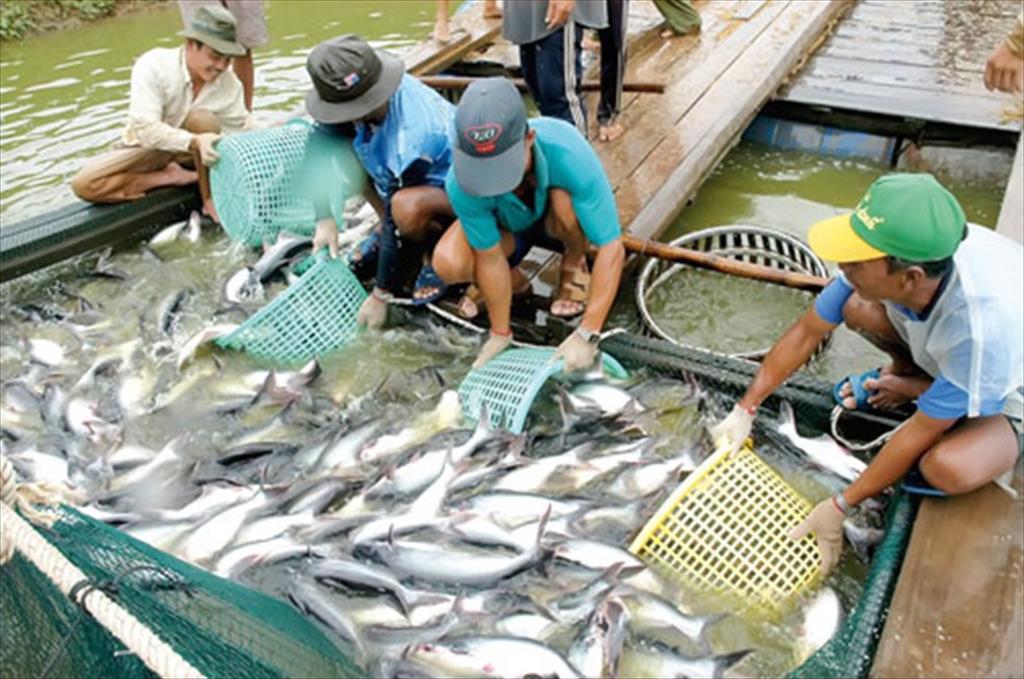(seafood.vasep.com.vn) Pangasius is one of the strategic farming species in the Mekong Delta region, in which An Giang is a locality with many advantages. Therefore, along with developing aquaculture, An Giang province has also invested in concentrated farming areas and specialized farming areas for breeding pangasius to restructure this potential industry.
Aquaculture development
An Giang is the upstream province of the Mekong River with an area of 3,536.7 km with 2 large rivers flowing through which are the Tien River (87 km in length) and Hau River (100 km in length), forming many natural tributary systems with a length of several kilometers to 30 kilometers, creating favorable conditions for aquaculture.
In the past years, An Giang's seafood industry has always had a high annual growth rate, about 8 - 9%/year and the proportion of added value of seafood in region I is about 12 - 15%; the annual seafood export turnover reaches more than 280 million USD, of which the main export product is pangasius.
In 2023, An Giang aquaculture industry has set 6 development goals. Specifically: (1) The growth rate of production value of the fishery industry is over 5% per year. (2) To develop the aquaculture area of 3,500 ha, in which the area for raising pangasius for export is 1,550 ha, the area for raising crayfish is 1,500 ha, the total volume of cage and raft farming is 1,057,000 m3, in which the volume of tilapia and red tilapia farming is 350,000 m3. Total aquaculture production is 621,180 tons/year, of which pangasius production is 482,755 tons/year, crayfish production is 1,500 tons/year, tilapia, red tilapia is 34,000 tons/year. (3) The main farming areas are all registered with farming codes and 80% are certified with farming standards (GAP, ASC, BAP...). (4) Developing areas for ecological aquaculture, organic farming, cage farming, and combined farming. Developing aquaculture for the purpose of landscaping and entertainment in cities, urban areas and tourist areas. Encourage the development of aquaculture in association with educational, tourism and sightseeing activities. (5) Developing aquaculture through a system of water storage reservoirs (natural lakes, artificial lakes), in newly formed saline intrusion areas due to the influence of climate change, the area for aquaculture development is 1,000 ha. (6) Develop essential infrastructure systems, especially irrigation systems to meet over 50% of demand in concentrated aquaculture areas.

Restructuring pangasius industry
Considered a driving factor of the province's economic development, An Giang province is restructuring the pangasius industry to become the pangasius breed production centre in the Mekong Delta.
According to information from An Giang Department of Agriculture and Rural Development, in 2022, the number of pangasius varieties produced in the province reached about 2 billion, equal to 110% of the same period in 2021. Pangasius production reached over 443,000 tons, up 33,000 tons compared to the same period in 2021. The area of pangasius associated with enterprises is over 1,068 hectares; in which the farming area associated with 9 enterprises is 210 ha, the farming area of the enterprise is 858 ha. Recently, the 3-level pangasius breeding program has been actively implemented by the province with accompanying projects to help develop the province's pangasius industry. By the beginning of 2023, An Giang has 9 pangasius hatcheries, with over 41,220 broodstock; in which 12,320 broodstock and breeding pangasius of good quality from Aquaculture Research Institute II to replace the brood stock of hatcheries.
An Giang currently has an area of 910 hectares of water surface for breeding pangasius, it is expected that in 2023 the province will increase by 70 hectares of water surface area for raising pangasius fingerlings. The growth area is mainly in the nursery areas, concentrated in a number of large seed production and nursing enterprises that have been put into production, increasing the rotation at enterprises such as: Nam Viet Binh Phu 150 ha; Vinh Hoan 48 ha; Viet Uc 10 ha, the rest of the seed area grows naturally by 10%. In 2023, Viet Uc has a plan to produce about 100 million fish; Vinh Hoan produced 30 million fish; Nam Viet and Nam Viet Binh Phu produced 100 million.

An Giang has set a target that by 2025, the province will stably develop concentrated pangasius farming area to reach 1,500 - 1,600 ha in Chau Phu, Chau Thanh, Cho Moi district, Long Xuyen city; develop models of pangasius farming applying high, advanced,environmentally friendly technology to adapt to climate change. An Giang has set a target of 70% of the pangasius farming area applying the certification standards required by the market, and 90% of the pangasius farming area granted the farming area code. The province also strives to become a pangasius breed production center of enterprises such as: Nam Viet Binh Phu 150 ha; Vinh Hoan 48 ha; Viet Uc 10 ha.... In 2023, Viet Uc has a plan to produce about 100 million fingerlings; Vinh Hoan produced 30 million fingerlings; Nam Viet and Nam Viet Binh Phu produced 100 million fingerlings.
The province also strives to become a pangasius seed production center of the Mekong Delta region by implementing the "Project on linking production of high-quality 3-level pangasius breeds in the Mekong Delta in An Giang". The project will focus on researching, consolidating, upgrading and expanding the scale of aquatic breeding centers to ensure the supply capacity of, and at the same time, proactively control breed source , treat and manage water source, environmental conditions, and increase survival rate of fry.
Currently, An Giang has 26 farms and farming areas that supply raw materials for 6 businesses that exports products to the US market with an area of 378.9 hectares, accounting for 30% of the province's farming area. Concentrated pangasius production areas, applying high technology have been formed and developed in An Giang, attracting many businesses to invest in large farming areas such as Viet Uc, IDI, Truong Giang.
Compiled by Thuy Linh